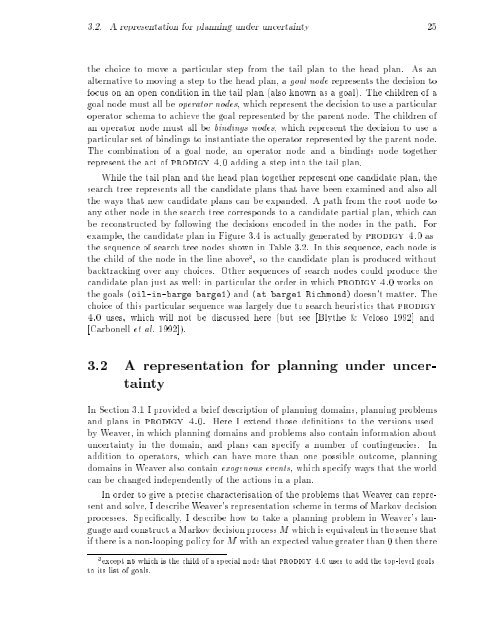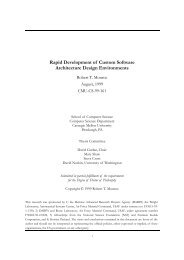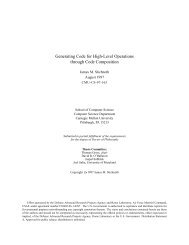Planning under Uncertainty in Dynamic Domains - Carnegie Mellon ...
Planning under Uncertainty in Dynamic Domains - Carnegie Mellon ...
Planning under Uncertainty in Dynamic Domains - Carnegie Mellon ...
Create successful ePaper yourself
Turn your PDF publications into a flip-book with our unique Google optimized e-Paper software.
3.2. A representation for plann<strong>in</strong>g <strong>under</strong> uncerta<strong>in</strong>ty 25the choice to move a particular step from the tail plan to the head plan. As analternative tomov<strong>in</strong>g a step to the head plan, a goal node represents the decision tofocus on an open condition <strong>in</strong> the tail plan (also known as a goal). The children of agoal node must all be operator nodes, which represent the decision to use a particularoperator schema to achieve the goal represented by the parent node. The children ofan operator node must all be b<strong>in</strong>d<strong>in</strong>gs nodes, which represent the decision to use aparticular set of b<strong>in</strong>d<strong>in</strong>gs to <strong>in</strong>stantiate the operator represented by the parent node.The comb<strong>in</strong>ation of a goal node, an operator node and a b<strong>in</strong>d<strong>in</strong>gs node togetherrepresent the act of prodigy 4.0 add<strong>in</strong>g a step <strong>in</strong>to the tail plan.While the tail plan and the head plan together represent one candidate plan, thesearch tree represents all the candidate plans that have been exam<strong>in</strong>ed and also allthe ways that new candidate plans can be expanded. A path from the root node toany other node <strong>in</strong> the search tree corresponds to a candidate partial plan, which canbe reconstructed by follow<strong>in</strong>g the decisions encoded <strong>in</strong> the nodes <strong>in</strong> the path. Forexample, the candidate plan <strong>in</strong> Figure 3.4 is actually generated by prodigy 4.0 asthe sequence of search tree nodes shown <strong>in</strong> Table 3.2. In this sequence, each nodeisthe child of the node <strong>in</strong> the l<strong>in</strong>e above 3 , so the candidate plan is produced withoutbacktrack<strong>in</strong>g over any choices. Other sequences of search nodes could produce thecandidate plan just as well: <strong>in</strong> particular the order <strong>in</strong> which prodigy 4.0 works onthe goals (oil-<strong>in</strong>-barge barge1) and (at barge1 Richmond) doesn't matter. Thechoice of this particular sequence was largely due to search heuristics that prodigy4.0 uses, which will not be discussed here (but see [Blythe & Veloso 1992] and[Carbonell et al. 1992]).3.2 A representation for plann<strong>in</strong>g <strong>under</strong> uncerta<strong>in</strong>tyIn Section 3.1 I provided a brief description of plann<strong>in</strong>g doma<strong>in</strong>s, plann<strong>in</strong>g problemsand plans <strong>in</strong> prodigy 4.0. Here I extend those denitions to the versions usedby Weaver, <strong>in</strong> which plann<strong>in</strong>g doma<strong>in</strong>s and problems also conta<strong>in</strong> <strong>in</strong>formation aboutuncerta<strong>in</strong>ty <strong>in</strong> the doma<strong>in</strong>, and plans can specify a number of cont<strong>in</strong>gencies. Inaddition to operators, which can have more than one possible outcome, plann<strong>in</strong>gdoma<strong>in</strong>s <strong>in</strong> Weaver also conta<strong>in</strong> exogenous events, which specify ways that the worldcan be changed <strong>in</strong>dependently of the actions <strong>in</strong> a plan.In order to give a precise characterisation of the problems that Weaver can representand solve, I describe Weaver's representation scheme <strong>in</strong> terms of Markov decisionprocesses. Specically, I describe how to take a plann<strong>in</strong>g problem <strong>in</strong> Weaver's languageand construct a Markov decision process M which is equivalent <strong>in</strong> the sense thatif there is a non-loop<strong>in</strong>g policy for M with an expected value greater than 0 then there3 except n5 which is the child of a special node that prodigy 4.0 uses to add the top-level goalsto its list of goals.







